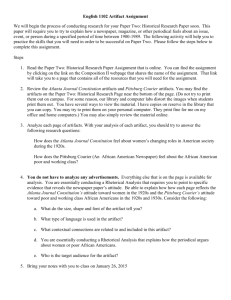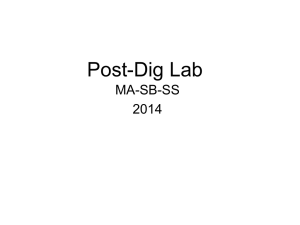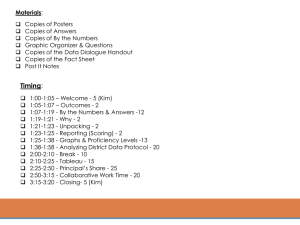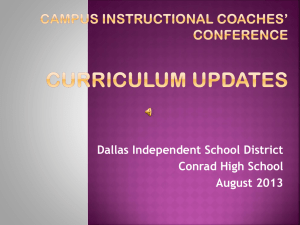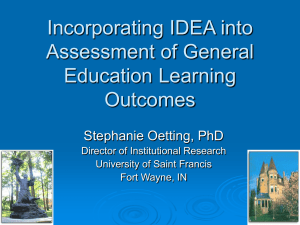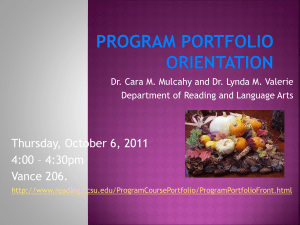PowerPoint - Fairfax County Public Schools
advertisement
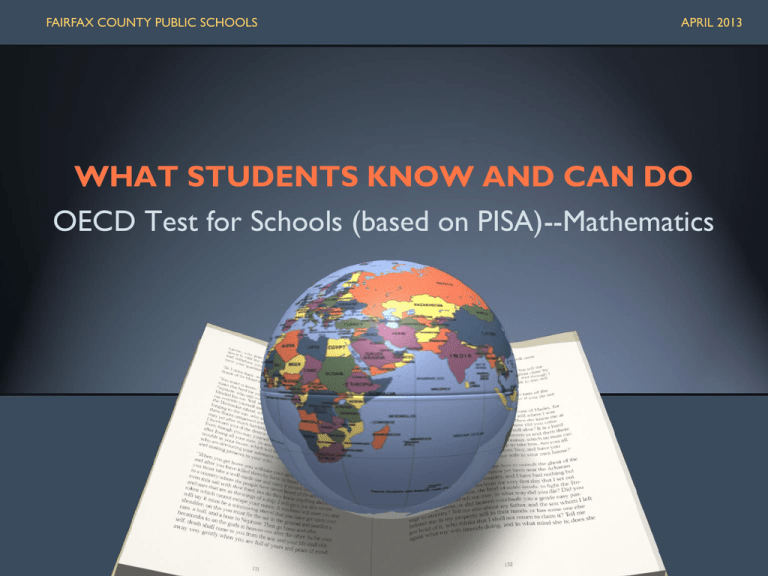
FAIRFAX COUNTY PUBLIC SCHOOLS APRIL 2013 WHAT STUDENTS KNOW AND CAN DO OECD Test for Schools (based on PISA)--Mathematics Assessment Items The Three Dimensions of Mathematics • Content- overarching ideas in relation to strands – Overarching ideas-patterns in space and shape, patterns in change and relationships, patterns in quantity, uncertainty – Strands- numbers, algebra and geometry • Process- general mathematical competencies – Reproduction- computations or definitions – Connections- connections to be made to solve relatively straightforward problems – Reflection- mathematical thinking, generalization and insight • Situation- personal, educational or occupational, public and scientific. Conditions and Format • Every task is in context of a real life situation • Many tasks have multiple parts • Combination of multiple choice and constructed response – Multiple Choice 14 – Constructed Response 26 • Opportunities to explain process or justify answer • Paper-pencil test • Calculators and other tools as they are normally used in school • No accommodations provided • 2 hours total for the entire test • Partial credit awarded Difficulty score of 406 Difficulty score of 439 Difficulty score of 586 Comparing VA SOL Questions and PISA Sample Tasks 2001 Geometry Standards A company makes two similar cylindrical containers. The total surface area of the small container is 0.81 times that of the larger container. The height of the larger container is 60 cm. What is the height of the smaller container? A. B. C. D. 54 cm 48.6 cm 24.3 cm 21 cm 2009 Geometry Standards Comparing Questions Performance Data Tear Share Overview Look Over the Artifacts Tear-Share Debrief Each Number Group Shares Adapted from Supporting Differentiated Learning Solution Tree 2011 Look at the Mathematics Artifacts Part 1: 7 minutes Explore the 4 artifacts related to the mathematics data Take notes on your graphic organizer while working. Adapted from Supporting Differentiated Learning Solution Tree 2011 Debrief Part 2: 7 minutes • Number off from 1 – 4. • Tear and share your box sections: – – – – All of the 1’s go to person 1 All of the 2’s go to person 2 All of the 3’s go to person 3 All of the 4’s go to person 4 Adapted from Supporting Differentiated Learning Solution Tree 2011 Sharing Part 3: 5 minutes Number groups summarize the responses in their boxes and prepare to share. Adapted from Supporting Differentiated Learning Solution Tree 2011 Artifact #1 Levels of Mathematics Performance Level Condensed Description 6 •capable of advanced mathematical thinking and reasoning •precisely communicate their actions and reflections 5 •select, compare, and evaluate appropriate problem- solving strategies •reflect on their actions and communicate their interpretations and reasoning 4 •use well-developed skills and reason flexibly, with some insight •can construct and communicate explanations and arguments 3 •execute clearly described procedures •apply simple problem-solving strategies •develop short communications reporting their interpretations, results and reasoning 2 •employ basic algorithms, formulae, procedures, or conventions •capable of direct reasoning and literal interpretations of the results 1 •identify information and to carry out routine procedures according to direct instructions in explicit situations. Artifact #2 FCPS Pilot School Performance Levels # of Students Tested Mean Score 73 539 45 489 48 503 61 522 56 553 49 464 105 443 73 567 112 680 47 558 669 540 487 Artifact #3 Falls Church HS – Climate in Mathematics Lessons Artifact #4 FCPS Pilot Schools Compared to US PISA Schools IN CLOSING… • The mathematics team in ISD has been working on performance tasks for students at all levels. • Summer Curriculum Projects include task creation for grades K – Algebra 2 • Grades K – 6 already have at least one task per quarter created. • The mathematics team is also continuing to focus on the 5 mathematics process goals • Problem Solving • Connections • Communication • Reasoning • Representations Artifact #1 What are you noticing about the differences between the levels? Artifact #2 What are two things that stand out? 1. 2. Artifact #3 What comparisons can you make about the FCHS data and other US students? How are they different? Artifact #4 What are you noticing about FCPS schools and other schools in the US?

